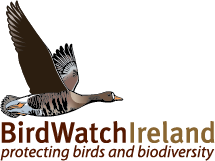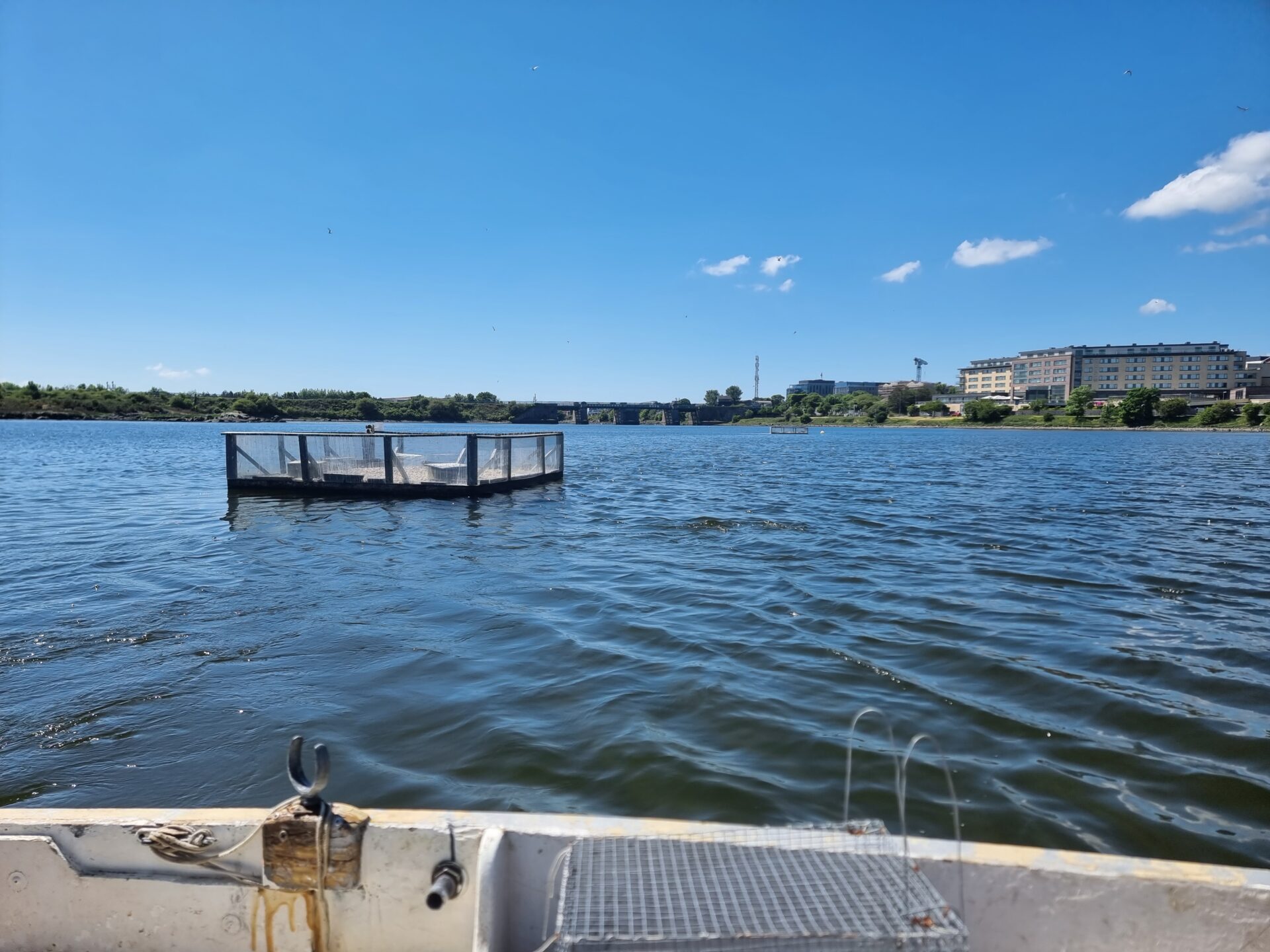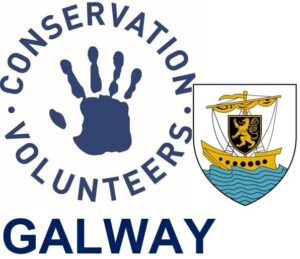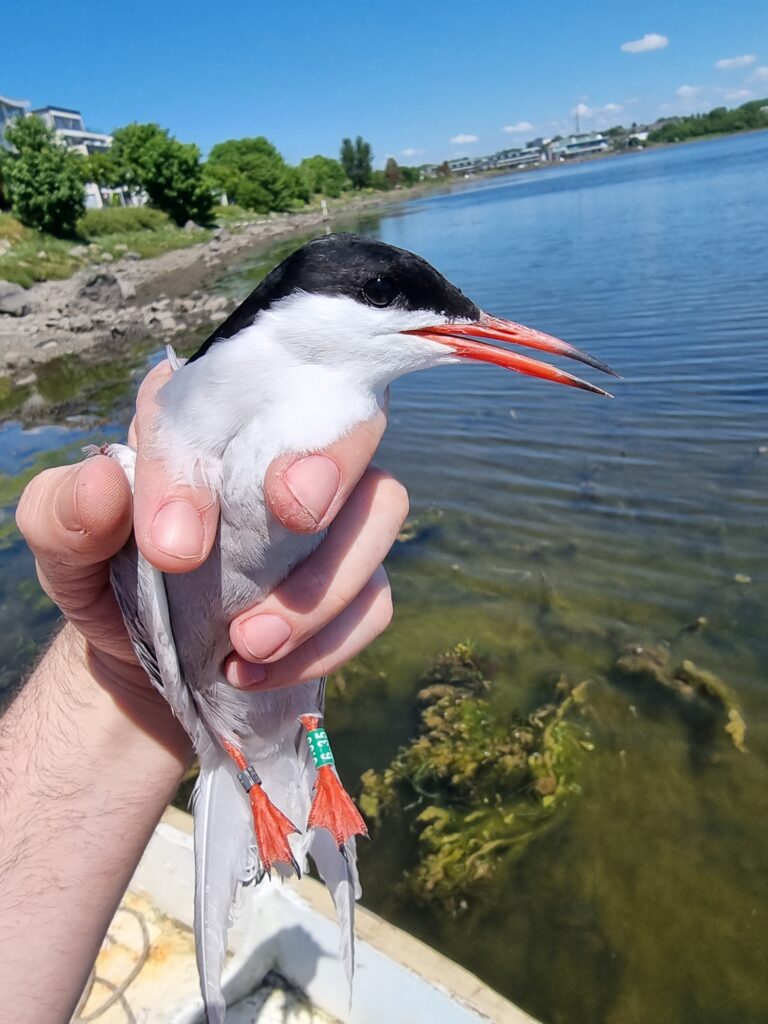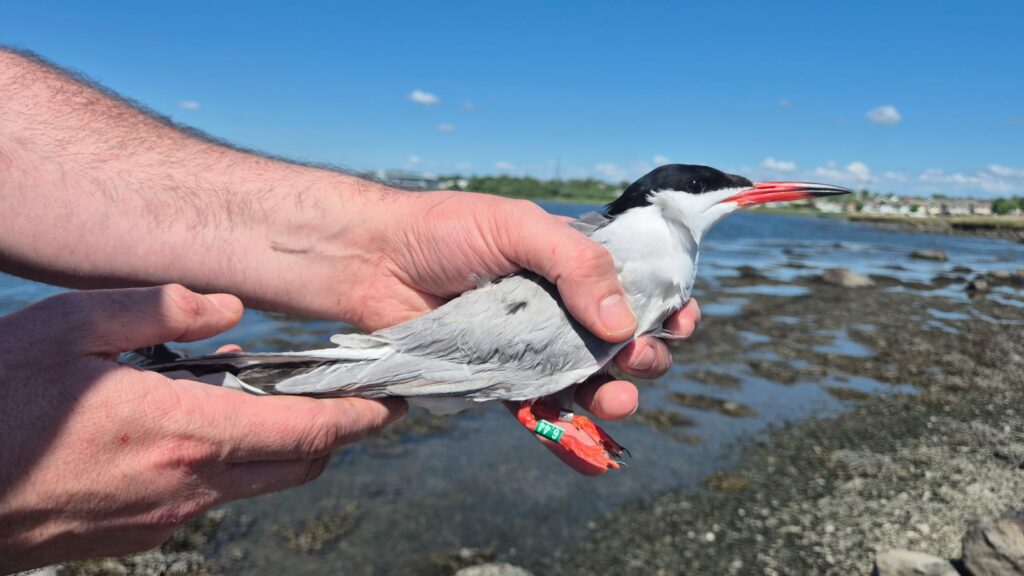For the past six years, Conservation Volunteers Galway and staff at the Atlantic Technological University have been protecting and monitoring nesting Common Terns in Galway City, to great success. The team have installed three rafts in Lough Atalia, designed to provide safe nesting habitat as an alternative to local sites that are subject to disturbance and predation. In recent years we have been delighted to be invited to assist them in their work by ringing the Terns so that we can find out more about them – their survival rates, where they go after leaving Galway, what other colonies they’re linked to, and more. This year the ringing work has been co-funded by Galway City Council and the National Parks and Wildlife Service under the Local Biodiversity Action Fund and we are very grateful to them for making this work possible.
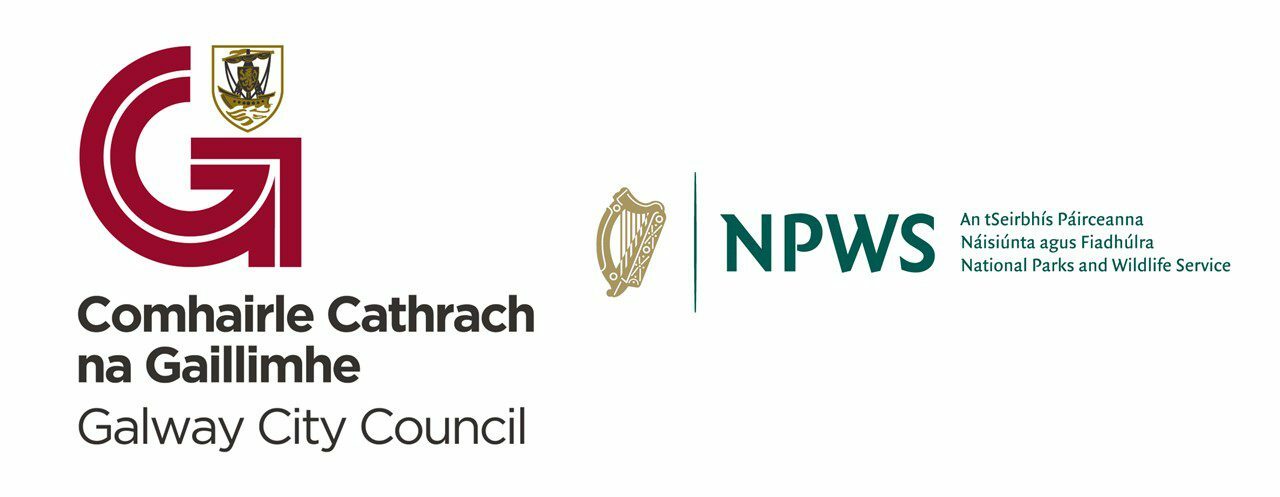
One of the artificial pontoons deployed in Lough Atalia to ensure Common Terns have somewhere safe and reliable to nest. Photo: Brian Burke.
Our first ringing visit took place in late May when most Common Tern pairs were more than halfway through the incubation period for their eggs. This was our first time to ring adult Terns in Galway. Small cage traps were carefully placed over nests, the ringing team moved away on the boat, and returned around 15 minutes later to take the birds out, ring them and quickly release them so they can go back to incubating their clutch again. BirdWatch Ireland do this sort of ringing at other colonies including Rockabill Island and Dublin Port to great success. While ringing chicks is useful and informative, it takes a few years for the chicks to return to the colony, whereas by ringing adults you can start to gather data much more quickly. We are hoping this ringing project will help us learn about the survival rates of the Galway Common Terns, their fidelity to the same platform and nest site, links with other colonies, as well as sites they use on their migration. We are using green colour rings with three numbers beginning with ‘6’ and a full stop, and these rings are also being used on Common Terns on Lough Ree in a project with the National Parks and Wildlife Service there, and will possibly be used at other sites in the west in the years to come.
One of the Common Terns nesting at Lough Atalia – caught and ringed under NPWS licence, and quickly released to return to the colony. The green coded ring is visible from a distance and will help us identify this individual in the future. Photo: Brian Burke.
In total we caught 14 adult Common Terns on this trip, almost all of which were not previously ringed, though the final bird of the day was sporting a metal BTO ring on its left leg. We added one of our colour rings so this bird can be more easily monitored in the future, and then very quickly sent the ring number off to the BTO to find out where and when it had come from! We were able to quickly check that it wasn’t from any of the NPWS or BirdWatch Ireland tern ringing projects on the east coast, and the chances of it being a Galway bird seemed slim even though a small number of tern chicks had been ringed in Galway in recent years.
It turns out this bird was originally ringed as a chick in July 2006, making it 19 years old! While Common Terns can live to their late 20’s, the vast majority are under 10 years old. If they survive beyond that they’re doing well, and to reach nearly 20 years old is fantastic! This individual was ringed in Cork Harbour as a chick – another colony on artificial structures in an urban port area. For context, the oldest Common Tern on record in Ireland was 23 years old.
This Common Tern, nesting in Lough Atalia in Galway in 2025, was originally ringed as a chick in Cork Harbour in 2006, making it 19-years old. Photo: Emily Marsh.
Conservation efforts at individual colonies like Lough Atalia, Cork Harbour, Dublin Port, Rockabill, Lady’s Island and elsewhere not only benefit that specific colony, but ensure there are more juvenile birds to spread to and help bolster and grow other sensitive colonies in other areas. Catching this bird was the icing on the cake of a successful day. The total number of nests present on this visit was 42 which was a very healthy number and really speaks to the success of this project by Galway Conservation Volunteers.
The first chicks started hatching in the last week of May and our intention was to make another visit to ring the chicks in late June before they fledged. Unfortunately the team in Galway reported that the colony was hit by what was suspected to be avian flu shortly after, resulting in the loss of almost all chicks, and many adults.
This outbreak has been devastating for the project team at Conservation Volunteers Galway, Atlantic Technological University and us at BirdWatch Ireland. This colony was hit by avian flu in 2023 alongside many other tern and gull colonies in Ireland and the UK, thankfully in 2024 there was no sign of avian influenza at the colony and an estimated 60 chicks fledged. Despite the negative end to this season, we shouldn’t forget how successful this project has been to date. Terns had struggled to nest successfully in inner Galway Bay due to predation and disturbance, and these platforms provided them with somewhere safe and reliable to nest. All we can hope now is that enough adults abandoned the colony without having caught avian flu and will survive to return next year. There will also be some young birds born here in recent years who are not yet old enough to breed, that will hopefully return in 2026 and beyond. The spread and impacts of avian flu only further underscore the importance of conservation projects like this, and we hope through continued ringing studies we can better evaluate the linkages between colonies to learn about the spread of avian flu and the hopeful recovery of the Common Tern population.
The Common Tern colour-ringing project at at Lough Atalia is co-funded by Galway City Council and the National Parks and Wildlife Service under the Local Biodiversity Action Fund. A special thanks to Galway City Biodiversity Officer Paula Kearney for her help and support with the project and to Emily Marsh for assistance with ringing.
Funding for the Lough Atalia Tern Conservation Project, by Conservation Volunteers Galway, has been provided by Atlantic Technological University, The Heritage Council, Galway Atlantaquaria, Galway City Tidy Towns and public donations.
